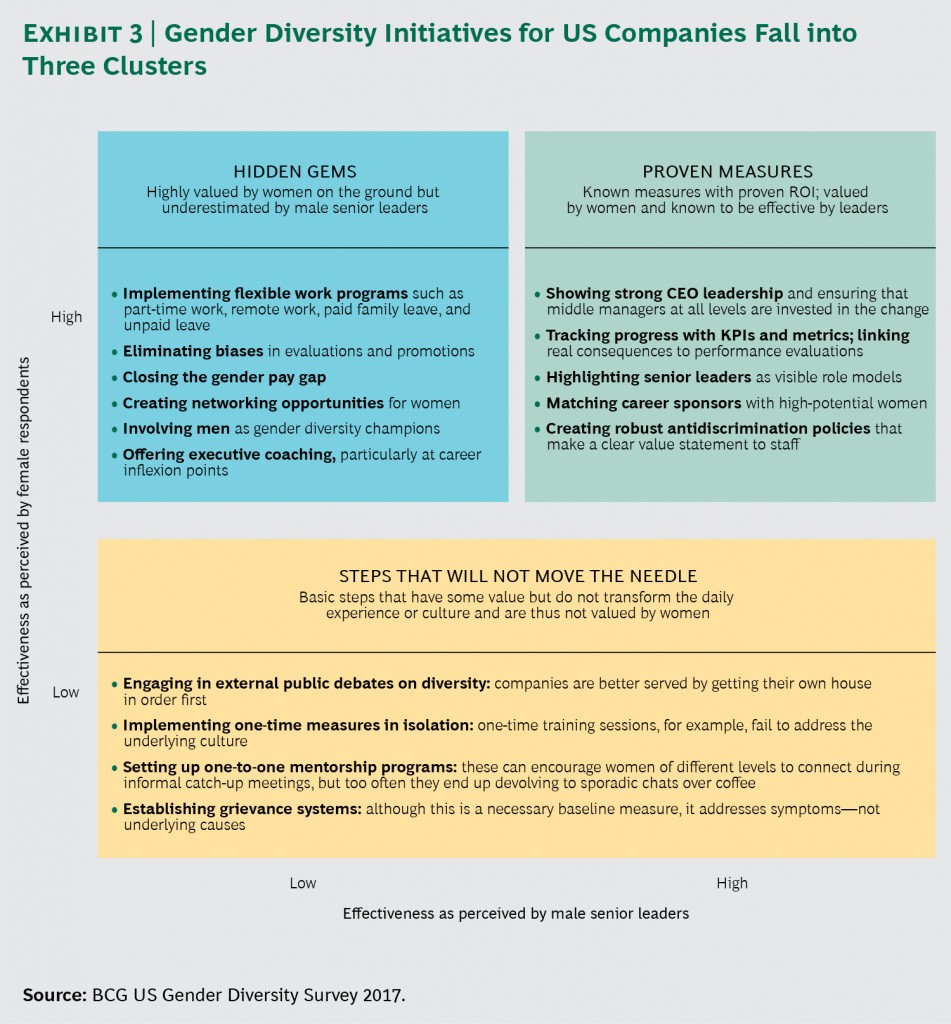2017 has been the year of recommitting to the retention and advancement of women in large law firms. Concerns that have been on the table for decades, solutions that have been proposed for just as long, frustrations as old as the hills. They’re back. Same articles, conferences, task forces, books and podcasts. Same story… and almost exactly the same powerful data.
So I haven’t been able to get as enthused as in the past when learning of new summits on the topic, new recommendations, new pundits. I’m constantly tempted to make deflating comments about wheel spinning when presented with evidence of a new diversity initiative. This isn’t good. I’m not that person. And, needless to say, my jaded contributions do nothing to address this rotten situation. Kind of like all my anguished social media posts about the state of the nation.
It is true that law firms in general are notorious for their unoriginal and, let’s be frank, unbusinesslike approach to strategic planning (e.g. defensive budgeting that runs out about as far as the firm’s next comp schedule or footprint upsizing), an unwillingness to invest on a meaningful scale in associates and other “human assets” and a defiant commitment to remain hogtied by the billable hour. Then again, there are plenty of reasonable, forward-thinking people of integrity, male and female, in positions of power at these firms. The business case for embracing more than just 50% of the top talent pool is clear—so couldn’t we begin to make some real headway, finally, right now?
Well, yes, I guess. Today I awoke feeling positive about two very different —but kind of connected –things. First, of course, the great state of Alabama. And second (having read a recent Boston Consulting Group study shared by Caren Ulrich Stacy, founder of the Diversity Lab), the possibility that some BigLaw leaders might finally be convinced to connect the data dots, with Caren’s help, and make some honest to goodness, and measurable, changes.

On the heels of her notable success establishing the OnRamp Fellowship women lawyer returnship program, Caren Stacy is now working with 44 leading firms to advance the Mansfield Rule (inspired by the NFL’s Rooney Rule) and effect concrete change in the near term. Firms committed to the Mansfield Rule agree to assure that at least 30% of the candidates affirmatively considered for promotions, senior level hiring and significant leadership roles must be women and lawyers of color. After a year, those firms can become “Mansfield Certified”, with the enviable chance to send their recently promoted diverse partners to a client forum to engage with and learn from in-house counsel. A smart business move, right? Please say yes. (So far, more than 55 legal departments at leading companies are supporting the Client Forum.)
This is cheering. I also think that the myth-busting data-driven studies in the news may change some minds. Among them, the study Caren Stacy shared last night, in which BCG endeavored to “understand the landscape of gender diversity”, especially in light of the sobering statistics Catalyst has been reporting for years. Specifically, BCG wanted to know why 89% of the male and female senior executives interviewed stated that their company had a gender diversity program in place, yet only 27% said they had actually benefited from the program.
The most compelling of BCG’s findings was the pronounced “mismatch” between the perceptions of women and those of senior (and almost all male) executives as to the primary impediments to gender diversity. “Women cited obstacles to advancement as the main source of slow progress, followed by retention. But fewer than 25% of male senior leaders agreed. (And among male respondents at all levels, only 15% of men see either retention or advancement as an issue.) Instead, male leaders typically cited recruiting as the biggest challenge, with 35% saying that it was an obstacle. By contrast, women ranked recruiting as the least important issue; fewer than 26% agreed that it was a challenge.”
The money quote : “The misperceptions matter. When leaders don’t have a clear idea of a problem, they simply aren’t able to solve it. Our research shows that companies are significantly underinvesting in advancement.” Of course. Why didn’t I think of that.
The BCG data supports what those of us involved in the diversity space have always known: Law firms are happy to invest money, time and people in the recruiting process. They are by no means as enthusiastic about allocating any of those resources to training, retaining and advancing diverse lawyers already on the payroll.
In my experience, ongoing relationship building and business development training for all lawyers (starting Day 1) and structured sponsorship programs (featuring high producing and influential partner sponsors) are critical components of any effective retention and advancement strategy. The BCG study results support this conclusion and more.
BCG ranks gender diversity initiatives as a function of their relative effectiveness, dividing them into “hidden gems, proven measures, and steps that will not move the needle”. I am hopeful that all of BigLaw management will at some point read this excellent report. Then we might be able to stop spending time and money on one-time diversity training programs, conference sponsorships and ineffectual mentoring programs and begin building a consensus for comprehensive institutional change instead.
Here’s a bullet summary of just one category from BCG’s conclusions– the “hidden gems”:
1. Implementing flexible work programs
2. Elminating (unconscious and conscious) bias in evaluations and promotions
3. Closing the gender pay back
4. Creating networking opportunities for women
5. Involving women as gender diversity champions
6. Offering executive coaching, especially at critical career inflection points
Unfortunately, there is also the possibility that the “it’s just a woman’s issue” clan (or, ever reliable, the highest paid silos) will carry the day. There are those, like Nicole Black (see this excellent ATL article), who believe that only a spate of lawsuits will move the needle. And there are times when I agree.
But then I consider the force of nature that is Caren Ulrich Stacy and I allow myself to hope. For now, I’ll follow the Diversity Lab and it’s founder’s activities closely, and count on the law firms and legal departments she has convened to be the first to move the proverbial heavens.
You may also like:
- Be a Twitter Scout and Make Some Rain: How to…
I am amazed at the number of smart, savvy, competent and competitive friends, colleagues and former partners who have ignored the prodigious power of social media….Ultimately, it is bad business to reject efficient new technologies. As an example, Twitter offers you the chance to “curate” as-it-happens news, and the resulting observations of the smartest commentators, on behalf of your professional network. Be their favorite scout. Watch for ways to help, and ways to protect. At a minimum you’ll learn to speak the language of their careers, a critical step in developing any business relationship and in winning the confidence of a potential client or referral source. Knowledge is power. And the confidence of knowledge makes navigating tough situations and managing impossible people vastly easier.
- Part 3: 5 Easy Ways to Help Your Network…and Grow…
Giving and helping are everything. The ideal way to build and deepen your rapport with your clients, prospects, colleagues, referral sources and other important contacts is to learn as much as you can about each person and identify what he or she needs to be successful and fulfilled. Once you’ve done that, things get very simple. You just need to help meet those needs. Here are five more simple ways to do that — drawn from my own practice and that of my partners and clients. Parts 4 and 5 still to come.
- Part 2: 5 Easy Ways to Help Your Network…and Grow…
Giving and helping are everything. The ideal way to build and deepen your rapport with your clients, prospects, colleagues, referral sources and other important contacts is to learn as much as you can about each person and identify what he or she needs to be successful and fulfilled. Once you’ve done that, things get very simple. You just need to help meet those needs. Here are five more simple ways to do that–drawn from my own practice and that of my partners and clients.
- 5 Easy Ways to Help Your Network…and Grow your Law…
Giving and helping are everything. The ideal way to build and deepen your rapport with your clients, prospects, colleagues, referral sources and other important contacts is to learn as much as you can about each person and identify what he or she needs to be successful and fulfilled. Once you’ve done that, things get very simple. You just need to help meet those needs. Here are 5 (out of 25) simple ways to do that–drawn from my own practice and that of my partners and clients. More to come in Parts 2 through 5….


